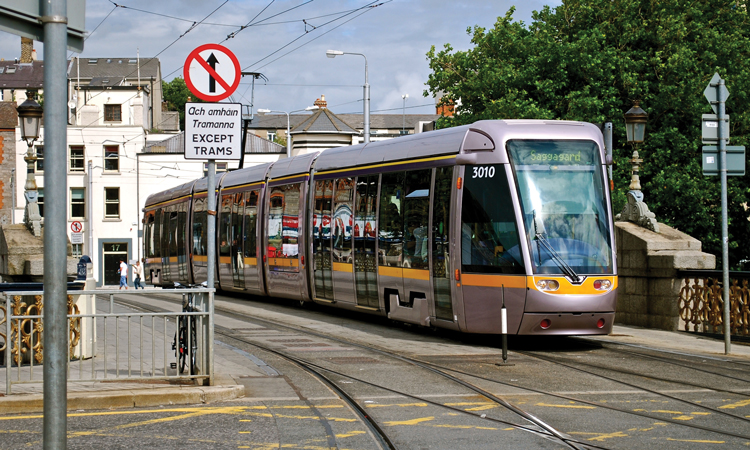Ireland’s integrated smartcard ‘Leap’ bounds ahead
- Like
- Digg
- Del
- Tumblr
- VKontakte
- Buffer
- Love This
- Odnoklassniki
- Meneame
- Blogger
- Amazon
- Yahoo Mail
- Gmail
- AOL
- Newsvine
- HackerNews
- Evernote
- MySpace
- Mail.ru
- Viadeo
- Line
- Comments
- Yummly
- SMS
- Viber
- Telegram
- Subscribe
- Skype
- Facebook Messenger
- Kakao
- LiveJournal
- Yammer
- Edgar
- Fintel
- Mix
- Instapaper
- Copy Link
Posted: 4 December 2015 | Barry Dorgan - National Transport Authority of Ireland | No comments yet
Barry Dorgan, Head of Ticketing Systems at Ireland’s National Transport Authority, sets out how integrated ticketing has developed and evolved in Ireland and its likely future direction.


National Transport Authority
The National Transport Authority of Ireland (NTA) is a state body set up in 2009 and is responsible for entering into contracts for the provision of public passenger land transport services; providing funding for specified bus and rail travel services that are considered necessary for economic or social reasons (i.e. Public Service Obligation contracts); licensing public bus passenger services and routes; regulating the taxi sector; promoting an integrated public transport network; and providing integrated ticketing, fares and information schemes.
Additionally within the Greater Dublin Area (the eastern region of the country which represents 40% of the population of Ireland) NTA has extra responsibilities that include: strategic planning of transport; development of an integrated, accessible public transport network; promoting cycling and walking; and provision for financing the construction of public transport infrastructure (including the Luas light-rail cross-city extension currently under construction).
NTA’s vision is to achieve a ‘Greater share of high quality, accessible sustainable transport being used by all’. A key enabler of this vision is the integrated smartcard, the ‘Leap Card’, launched in December 2011 and now the predominant and most convenient way of paying for public transport.
The integrated smartcard: the ‘Leap Card’
The Leap Card is Ireland’s national transport smartcard. As well as being accepted on all Dublin Bus, Luas light-rail, and Irish Rail services around Dublin, it can also be used in several regional cities, including on Bus Éireann’s services in Cork, Galway, Limerick and Waterford, as well as on 10 licensed private bus operators, including Wexford Bus, Matthews Coaches, Swords Express, City Direct, Collins Coaches, and more.
For the Leap Card, NTA selected the NXP DESFire EV1 4k chip. It has the processing power and encryption/decryption capabilities and has sufficient memory for our requirements. In order to integrate with the existing ticketing equipment, we chose to develop our own physical reader to become the standard Leap Card reader for all devices. The reader fully manages the smartcard interface and looks after security, presenting simplified, high level messages to the host devices which can be quickly and simply processed. The Leap reader module replaces the card reader circuit in existing equipment and is developed and managed by NTA. Over 6,000 Leap readers are now live in the field across 14 different ticketing devices.
How it the Leap card works
Having initially launched with pay-as-you-go travel credit (i.e. pre-paid stored value) on child, adult and student Leap Cards, NTA has since expanded its range of offerings to provide greater choice and smarter options to customers by introducing a range of additional features to the Leap Card. These features include:
- 1-Day and 7-Day price capping on Dublin Bus, Irish Rail and Luas services
- 1-Day and 7-Day combined (multi-operator) price capping across all three operators
- ‘Leap 90’ discounts for customers making multi-leg journeys
- A range of single operator and multi-operator pre-paid tickets
- Travel Credit Auto Top-up, post-paid via direct debit
Pay-as-you-go and price capping
Travel credit can be loaded onto Leap Cards at Irish Rail and Luas ticket vending machines or at over 700 Leap retail agents nationwide, or purchased online for subsequent collection. The Luas light-rail and Irish Rail services operate a ‘check-in check-out’ approach with the maximum fare deducted at check-in and then a rebate is applied on check-out to ensure the correct fare has been charged.
Bus services operate a ‘check-in’ only approach whereby the exact fare is deducted on tag-on (via the driver) or alternatively a flat fare is deducted by a remote validator for longer journeys.
With price capping, customers paying using travel credit can benefit from separate one-day and seven-day price caps on Dublin Bus, Luas and Irish Rail services. The system adds up how much Travel Credit the customer has spent on each operator’s services on a given day or week and then it stops deducting any more travel credit once the Cap value for that operator has been reached.
On top of operator specific caps, a separate multi-operator ‘Dublin Cap’ is also offered for those customers who use more than one operator’s services. For customers who use a combination of Dublin Bus, Luas, and Irish Rail, their Travel Credit use will be capped at the rate of the Dublin Cap, even if individual operator caps have not been reached.
The advantage of these features is that it has replaced a range of one-day and seven-day tickets and thus allows for simplification of the product offering, while for customers the great advantage is that they can now automatically benefit from the caps without having to pre-select a particular ticket type and it is cheaper, as Leap Card fares are typically 20% cheaper than cash. Fare simplification and aggregation is an on-going activity for the NTA as part of an annual fares determination process.
To complement price capping, and to replace through tickets, NTA has also introduced a ‘Leap 90’ transfer discount for customers who use travel credit to pay for two or more trips within 90 minutes of each other. When customers check-in for their second and subsequent journeys, a fixed discount is automatically deducted off the fare.
To ensure that the financial impacts of the fare foregone arising from capping and transfer discounts are equitably distributed across the transport operators, NTA has developed an in-house system to manage the fare foregone on each transaction. Once a week, the system reassembles each capped or discounted journey and then reallocates funds between the relevant transport operators so as to ensure an equitable apportionment of the total amount of fare foregone.
Pre-paid tickets and additional features
In addition to using travel credit on a pay-as-you-go basis, customers have a choice of a wide range of prepaid single-operator and multi-operator tickets such as monthly and annual passes, 10 journey tickets and coupon tickets providing five or 30 non-consecutive days of travel. Each Leap Card can hold up to five tickets concurrently.
In 2014, NTA introduced Auto Top-Up as a way of automatically reloading travel credit with the money subsequently being deducted from the customer’s bank account. This was the first post-paid offering on Leap Card and currently accounts for just under 3% of monthly top-ups.
Also in 2014, a disposable tourist card was introduced, providing three days of unlimited travel in Dublin; this was supplemented in 2015 with the addition of 1-Day and 7-Day variants, which can be reloaded onto a flexible (polyester) Leap Card.
In 2015 we collaborated with the Department of Social Protection so that the Public Services Card, used to collect social welfare payments, could become Leap enabled so that those entitled to Free Travel (concessionary travel) could be read by the Leap Card readers. The Department has issued over 513,000 of these cards and since May 2015 over 5.3 million usage transactions have been recorded. This collaboration is expected to have a positive impact on revenues by reducing fraud as the Leap enabled free travel passes replace less secure formats.
Leap: a significant milestone
In April 2015, Leap Card hit a significant milestone with the issuance of the 1,000,000th Leap Card. But the growth has not stopped there – by the end of October 2015, the number of Leap Cards issued exceeded 1.3 million, and altogether 165 million journeys had been taken using travel credit (with an aggregate value exceeding €228 million), and a further 56 million journeys have been made using tickets.
In October 2015, Leap processed over €12 million worth of top-ups and over €7.3 million in tickets were sold. Overall, the Leap Card scheme accounts for approximately 70% of public passenger revenues and on average 3.5 million contactless transactions are generated each week.
Benefits of the smartcard
The success of Leap Card has enabled NTA to moderate the impact of fare increases on passengers which were necessary to offset cutbacks in subvention. NTA has also been able to rationalise and streamline the range of public transport fares and to offer new products for different customer categories. The rules for child tickets have been standardised and extended to apply to children aged up to 19 years old, subject to possession of the appropriate Leap Card. Furthermore, the availability of Leap as a viable alternative for customers has meant that NTA has been able to increase the cash fare to the point where Leap Card fares are 20% cheaper than the equivalent cash fare.
For transport operators, access to the nationwide point-of-sale network, and the availability of electronic versions of tickets that can be loaded onto Leap Cards, has meant that operators could eliminate magnetic and/or proprietary non-integrated smartcards as well as reducing their cost of sales. For many smaller bus operators in particular, access to an electronic reload network may not have been feasible otherwise. In addition, the launch of capping and Leap 90 discounts has meant that it has been possible to simplify the range of tickets as smarter Leap offerings supersede non-integrated tickets.
For customers, despite the fact that Leap fares are cheaper than cash, the greatest benefit that stands out in all market research is convenience (ease of use) followed by the fact it facilitates customers not having to carry cash. A further positive outcome is that 44% of customers surveyed claimed that their usage of public transport has increased since getting their Leap Card, and while this is only a few journeys per week for some, over a third of those stated that they now make two extra journeys per week as a result – thus increasing transport operator revenues.
Current developments
One of the most exciting developments underway on Leap is the implementation of an NFC top-up app. The introduction of this app, initially on suitably equipped Android phones, will give more control to customers by enabling them to check their balance on the go, top-up at home and collect ticket renewals.
This app will address one of the key pain points of card centric schemes, i.e. the need for customers to nominate a collection location for internet top-ups as well as freeing-up customers so that they can reload their card at a time and location that suits them. Subsequent enhancements will enable customers to view their proximity to the cap and any savings that they have made due to capping and Leap 90 discounts.
Future activity
Much work has been done in delivering Leap Card by NTA, the transport operators, and their equipment suppliers. NTA had the opportunity of studying what was developed elsewhere in Europe (and beyond), and benefitted from lessons learnt in these earlier smartcard systems. As a result, Ireland was in a position to deliver a well-developed smartcard system in a single step.
The next jump is likely to see Leap Card evolving from a card-centric scheme into a comprehensive account-based travelling solution, including contactless EMV acceptance and using this capability as an enabler for mobile payments via Apple Pay, Google Wallet and similar. The concept of a ‘mobility account’ managing payment for multiple transport methods (such as bike rental schemes and car hire) beyond just paying for public transport is a powerful one, and also provides the added possibilities of potentially offering smarter ticketing solutions for cross-border travel with Northern Ireland.
NTA is avidly studying similar implementations and as a preparatory step has commenced in-house development of a virtual Leap Card reader (i.e. as a software kernel, to supersede the current physical reader) that can be incorporated into devices and ticketing machines. The first iteration of this virtual Leap reader has been implemented in an Android-based portable ticket machine that has just completed a successful pilot with a private bus operator and will shortly be rolled-out to further bus companies.
However, despite the potential offered by account-based solutions, NTA will continue to be objective-led regarding implementing new ticketing systems. It is acutely aware of the requirement to maintain, update and protect the current Leap systems, and therefore only those systems that deliver tangible customer benefits will be brought forward.
The intention of the Leap Card is to reduce the inconvenience of paying for public transport, and in so doing, to increase the chance that customers will choose to use public transport more often. Key issues in the future are likely to include: applicability of Leap to long distance travel; the cost of acceptance of contactless EMV (for customers as well as for operators), the customer experience of using bank cards and mobile payments on new ticketing equipment, adapting to customer communications expectations in the world of social media, and particularly, satisfying the customer expectations that, now that Leap Card has become a part of passengers daily lives, that its successor will be better.
Biography


Related topics
Ticketing & Payments
Issue
Issue 6 2015
Related cities
Ireland
Related organisations
National Transport Authority of Ireland
Related people
Barry Dorgan







